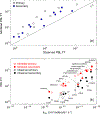On the sources and sinks of atmospheric VOCs: an integrated analysis of recent aircraft campaigns over North America
- PMID: 33688334
- PMCID: PMC7939023
- DOI: 10.5194/acp-19-9097-2019
On the sources and sinks of atmospheric VOCs: an integrated analysis of recent aircraft campaigns over North America
Abstract
We apply a high-resolution chemical transport model (GEOS-Chem CTM) with updated treatment of volatile organic compounds (VOCs) and a comprehensive suite of airborne datasets over North America to (i) characterize the VOC budget and (ii) test the ability of current models to capture the distribution and reactivity of atmospheric VOCs over this region. Biogenic emissions dominate the North American VOC budget in the model, accounting for 70 % and 95 % of annually emitted VOC carbon and reactivity, respectively. Based on current inventories anthropogenic emissions have declined to the point where biogenic emissions are the dominant summertime source of VOC reactivity even in most major North American cities. Methane oxidation is a 2x larger source of nonmethane VOCs (via production of formaldehyde and methyl hydroperoxide) over North America in the model than are anthropogenic emissions. However, anthropogenic VOCs account for over half of the ambient VOC loading over the majority of the region owing to their longer aggregate lifetime. Fires can be a significant VOC source episodically but are small on average. In the planetary boundary layer (PBL), the model exhibits skill in capturing observed variability in total VOC abundance (R 2 = 0:36) and reactivity (R 2 = 0:54). The same is not true in the free troposphere (FT), where skill is low and there is a persistent low model bias (~ 60 %), with most (27 of 34) model VOCs underestimated by more than a factor of 2. A comparison of PBL: FT concentration ratios over the southeastern US points to a misrepresentation of PBL ventilation as a contributor to these model FT biases. We also find that a relatively small number of VOCs (acetone, methanol, ethane, acetaldehyde, formaldehyde, isoprene C oxidation products, methyl hydroperoxide) drive a large fraction of total ambient VOC reactivity and associated model biases; research to improve understanding of their budgets is thus warranted. A source tracer analysis suggests a current overestimate of biogenic sources for hydroxyacetone, methyl ethyl ketone and glyoxal, an underestimate of biogenic formic acid sources, and an underestimate of peroxyacetic acid production across biogenic and anthropogenic precursors. Future work to improve model representations of vertical transport and to address the VOC biases discussed are needed to advance predictions of ozone and SOA formation.
Figures










References
-
- Akagi SK, Yokelson RJ, Wiedinmyer C, Alvarado MJ, Reid JS, Karl T, Crounse JD, and Wennberg PO: Emission factors for open and domestic biomass burning for use in atmospheric models, Atmos. Chem. Phys, 11, 4039–4072, 10.5194/acp-11-4039-2011, 2011. - DOI
-
- Amos HM, Jacob DJ, Holmes CD, Fisher JA, Wang Q, Yantosca RM, Corbitt ES, Galarneau E, Rutter AP, Gustin MS, Steffen A, Schauer JJ, Graydon JA, Louis V. L. St, Talbot RW., Edgerton ES., Zhang Y., Sunderland EM.: Gas-particle partitioning of atmospheric Hg(II) and its effect on global mercury deposition, Atmos. Chem. Phys, 12, 591–603, 10.5194/acp-12-591-2012, 2012. - DOI
-
- Andreae MO and Merlet P: Emission of trace gases and aerosols from biomass burning, Global Biogeochem. Cy, 15, 955–966, 10.1029/2000gb001382, 2001. - DOI
-
- Apel EC, Emmons LK, Karl T, Flocke F, Hills AJ, Madronich S, Lee-Taylor J, Fried A, Weibring P, Walega J, Richter D, Tie X, Mauldin L, Campos T, Weinheimer A, Knapp D, Sive B, Kleinman L, Springston S, Zaveri R, Ortega J, Voss P, Blake D, Baker A, Warneke C, Welsh-Bon D, de Gouw J, Zheng J, Zhang R, Rudolph J, Junkermann W, and Riemer DD: Chemical evolution of volatile organic compounds in the outflow of the Mexico City Metropolitan area, Atmos. Chem. Phys, 10, 2353–2375, 10.5194/acp-10-2353-2010, 2010. - DOI
